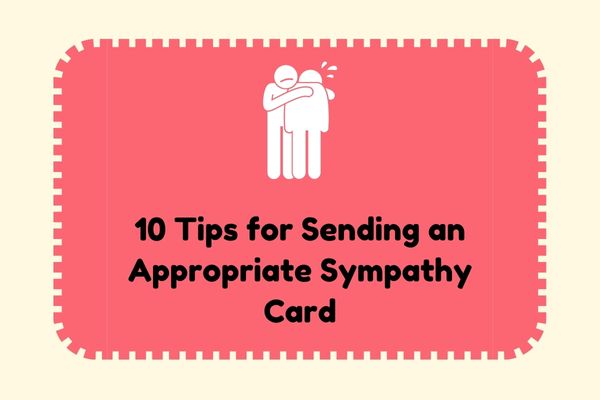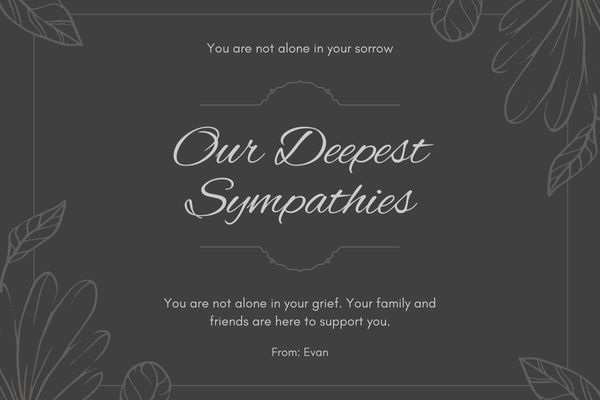10 Tips for Sending an Appropriate Sympathy Card – Do’s & Dont’s

Creating a sympathy card message is seldom easy. Sending a sympathy card is a thoughtful way to show support for someone who is grieving. Here are ten tips to make sure your card is appropriate.
You feel very bad about the fact that someone you care about is injured. And considering he needs help, it’s hard to know what to say. Identifying your considerations with originality can be significantly more exciting.
The perfect sympathy card is right in front of you, the pen ready for the preparation, and yet your psyche is crystal clear.
Nervous collapse … Where do I start? … What would you advise me to say? … considering the possibility that it could aggravate the situation.
Here are some Tips for Sending an Appropriate Sympathy Card to your loved ones. There are some basic tasks to avoid that will help you write a truly remarkable condolence note.
Take a deep breath or, above all, don’t overdo it!
Your fighting style shows that you are an attentive and realistic partner, and that means a lot.
You don’t have to have perfect words as long as your words are honest. Your condolence card is a valuable gift that will tell your partner that you are thinking about him and that you are thinking about him again.
Trust that with the perfect motivation, you really want to do it effectively.
How to Send a Sympathy Card
Sending a sympathy card is a thoughtful way to show support for someone who is grieving. However, it can be difficult to know what to say or write in a sympathy card. Here are some tips on what to do and what not to do when sending a sympathy card.

#1. Choose a basic or transparent card.
Fight the urge to send a greeting card with a long message printed on it. Too many people choose cards from card organizations that make up words so you don’t have to …
Pick a sympathy card that is simple and tasteful. Avoid anything that is too flashy or Inappropriate.
However, you can trust that a living card with more individual letters will mean a lot more to your partner. It allows you to customize the card and shows that you have requested some investment to express your sympathy in a smart and conscious way.
#2. Write in Your Own Hand
Always write your letter by hand. This may sound obvious, but in this age of email and text reporting, many people are already considering electronic options. Please do not do this.
Writing a sympathy card is the only time you really want to give up innovative features and say “no doubt” about the snail mail.
Many people keep all of their sympathy cards and feel comfort by keeping them as they mourn. Sending an email, Facebook book, or an instant message via mobile phone is not appropriate.
There is no match for a written condolence card.

#3. Consider Your Partner’s Personality
Think about your partner’s personality. As you choose a sympathy card, trust your feelings. If the person receiving the card is stern, a card with catchy words from the book of Scripture might be a good match (even if you’re not particularly strict).
He was referring to the person who died. This may seem really necessary for mourning, but people’s messages of condolence often focus on the recipient’s suffering.
In any case, most afflicted people say that having a card with a single memory really helps them heal, so sharing an unusual memory or thinking about leaving it canned is crucial.
In the absence of a one-on-one relationship between you and the deceased, you can certainly relax and not strain to make a memory. Just know that the message on your sympathy card will be valuable.
#4. Offer To Help
Suggest help with a specific goal in mind. Even though they need it and are looking for help, people who cry a lot are not looking for help because they do not want to be bothered.
It really helps to offer help in an explicit way, e.g. (I’d like to bring Ben home from school permanently for the next two weeks; I’d like to mow his lawn next month).

#5. Don’t Try to Sympathise
Let him know that your loved one is in an ideal situation or in a great place. They can trust it. They can try to say it. You’d rather not be the one to serve that tasteless bromide, though. To be honest, this comment never helps in worsening and reassuring the bereaved person.
#6. The tone of the Card
It is important to be aware of the tone of the sympathy card. The tone should be respectful and compassionate. Avoid using humor, as this can come across as insensitive in some cases.
#7. Relationship Between You & the Receiver
It is also important that the sympathy card is appropriate for the relationship between the sender and the recipient. For example, a card from a close friend or family member can be more personal than a card from an acquaintance.
#8. Keep The Message Short & Simple
Keep the message of the sympathy card short and simple. A few words of support or a quote can be more effective than a long message.

#9. Include a Return Address
Finally, make sure to include a return address on the sympathy card in case the recipient wants to write back.
#10. Share a Memory
If you know the deceased, try to personalize the card with a memory shared inside joke. Try sending an Appropriate Sympathy Card with humor.
Conclusion
Harp of bad luck. When you don’t know what to say, it’s perfectly normal for unsatisfactory expressions to go from pen to paper. Unfortunately, the sympathy card is not alone in many better details.
When someone you know is grieving, it can be difficult to know what to say or do. Often, the simplest way to show your support is to send a sympathy card. A sympathy card is a small gesture that can make a big difference for someone who is grieving.
By following these tips while sending an appropriate sympathy card, you can show your support and care for someone who is grieving.






